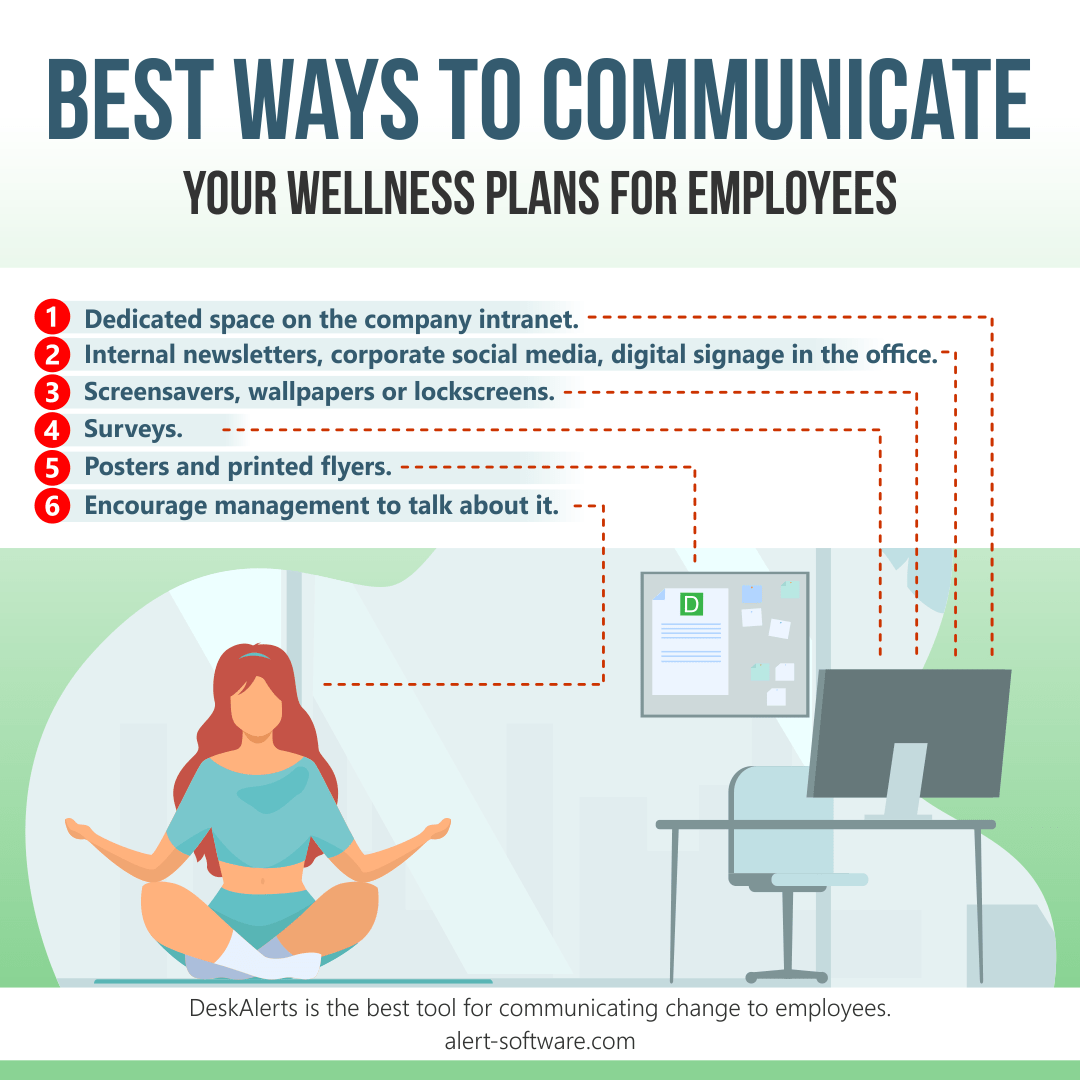
The COVID-19 pandemic has highlighted the need for employers to prioritize their employees’ health and wellbeing - both in terms of physical and mental health - as the virus takes a toll. One of the ways that employers can address COVID-19, as well as other health issues, is via an employee wellness program.
Employee health and wellness programs are used to improve the health and wellbeing of employees in a company, usually through preventative care to manage chronic diseases and/or to encourage employees to improve health and avoid behaviors that are unhealthy.
According to the Society for Human Resource Management, around 75% of employers in the USA offer their employees some type of wellness program.
Employee wellness programs' benefits include increased productivity, improved workplace culture and a potential reduction in absences.
Statistics from the ITA Group reveal that workplace wellness programs can result in 28% less sick days and 26% less health costs.
They are also attractive when people are choosing an employer.
According to a Virgin HealthMiles/Workforce survey, around 87% cent of employees consider a company’s health and wellness offerings when choosing to work for a company.
Employee wellness programs and COVID-19: why they are so important right now
COVID-19 seems as though it will be with the world for some time to come, and in many places it means that shelter in place restrictions are still in force, with employees working from home or having to take extra health and safety precautions if they work in roles that can’t be performed remotely.
All of this uncertainty and stress caused by the coronavirus can significantly affect your employees’ wellbeing and mental health. Your company’s most important asset is its people, and your company’s workplace wellness program can assist your employees to navigate these challenges to promote and encourage wellness during COVID-19.
(If you plan to survey the level of anxiety of your employees, use this workplace stress questionnaire.)
The way you deliver the resources that are part of your employee wellness program, however, may need to change.
A recent survey from Health and FIdelity Investments found that US employers have spent an average of $3.6 million on their workplace wellness programs, however many of the perks of the programs have been focused on employees being present in the physical office environment and are not always relevant to the current coronavirus situation.
During COVID-19 you could consider the following changes to your workplace wellness program to ensure your employees are able to still access and utilize it:
- Offer access to online workouts and fitness apps so employees can exercise while in isolation and while gyms are shut due to coronavirus. There are many different providers of these programs on the market and you can also organize bespoke programs customized to your workplace.
- Provide simple pieces of fitness equipment such as dumbbells or resistance bands to help employees work out at home. When you purchase this sort of equipment in bulk you may find that you can get a wholesale discount.
- Provide access to online counseling services for mental health, financial distress, relationship difficulties and so on. There are a number of providers in the market that offer these confidential services, with qualified counselors, and charge the company, not the employee.
- Deliver webinars on a range of topics from healthy eating to stress management. You can make your own featuring employees who have the trust and respect of their colleagues.
- Offer virtual ergonomic and workplace safety assessments for remote employees. This is actually quite important as you also run the risk of lawsuits from remote employees who injure themselves at work because they don’t have appropriate workplace conditions.
- Provide access to nutrition and healthy eating information. You can even hire a nutritionist as a consultant to provide one-on-one advice or deliver presentations to employees.
- Provide a space on your intranet or corporate social network where employees can discuss health and fitness goals. This can be in the form of a forum or a group chat or a Teams channel dedicated to health and fitness and employees encouraging one another.
- Entourage virtual fitness challenges among remote team members who can compete against their colleagues. For example, you may run a six-week challenge where every team member tries to walk 10,000 steps.
- Promote mindfulness. For example, you can give your employees access to mindfulness apps or encourage and promote meditation in the workplace.
- Encourage employees to take regular breaks. A good way to remember to do this is to have them set regular reminders and alarms throughout the day so that they can get up and move around and move away from their work.
Read more: Return to work notice to employee
Workplace wellness programs in the world after the coronavirus pandemic

There’s no doubt about it: the coronavirus pandemic will change the world, including the world of work, forever. When employees do begin returning to the physical office environment again, workplace wellness programs will need to change once more.
The actual return to the workplace may present wellness challenges for many employees and will be one they need support to transition to. In addition to having to put preventative health and safety measures in place to ensure physical safety for employees, many will have ongoing issues with fear and anxiety around the coronavirus and its implications for their health and economic security.
Even as the threat of COVID-19 diminishes, your corporate employee wellness programs will have an important role to play in improving your employees’ wellbeing and productivity. It’s likely that programs will be a hybrid of traditional workplace wellness programs as well as some of the new initiatives that employees got used to, appreciated or enjoyed during the remote working period.
Some of the initiatives to consider for your workplace wellbeing program in the post-COVID-19 world include:
- Workplace preventative health screening.
- Continued access to telehealth.
- Combination of exercise benefits including gym memberships and online workout apps.
- Include more resources in video format.
- Healthy food in the workplace.
- Access to healthy recipes for at home.
- Team health challenges or activities such as walking groups.
- Greater access to flexible hours/remote working to improve work/life balance.
- Provide seasonal flu shots.
- Send wellness newsletters.
- Continue to invest in mental health programs.
- One-on-one coaching sessions.
How to communicate your workplace wellness program to your employees
Once you create your corporate wellness solution, it’s important that you communicate with employees about what the plan is and the different features it contains. An internal marketing campaign is the best way to do this, ensuring that you showcase the different features and benefits of your employee wellness programs, in a variety of ways, using different channels. Remember, it can take seeing or hearing about something several times before the information is retained by the recipient, and initiatives for wellness during COVID are no exception.
Your communication should be clear and concise, and you should also use images wherever possible. Many people prefer visual communications to text, and at the same time you can show your workplace wellbeing program as being polished, professional and consistent with your company’s branding.
Timing is important when it comes to delivering your messages. Some things may be seasonal - for example, any messaging around flu shots. Other things will depend on when your employees are likely to see the information - sending something late on a Friday evening, for example, is not going to be as effective as if you send it in the morning.

Some of the best ways to communicate your wellness plans for employees include:
- Creating a dedicated space on the company intranet where all the employee wellness program information can be accessed.
- Promotion through internal newsletters.
- Creating images, either photos or graphics, for your corporate social media.
- Creating colorful visual displays with digital signage in your office environment.
- Creating custom screensavers, wallpapers or lockscreens promoting wellness initiatives that are deployed to every employee’s desktop screen.
- Creating and sending pop-up video alerts showcasing the wellbeing program’s benefits.
- Include information about different aspects of the program on a scrolling news ticker that appears on your employees’ computer screens.
- Send surveys to employees to determine if they know about the program and what else they’d like to see included.
- Posters and printed flyers.
- Digital wellness flyers.
- Webinars.
- Encouraging management to talk to their teams about the program at meetings.
***
There are many wellbeing challenges to deal with during the coronavirus pandemic and beyond - but investing in employee wellness in the workplace is both beneficial for employees and employers alike and can help with the transition to life after the pandemic.
Frequently Asked Questions
What are some recommendations for employers during the COVID-19 pandemic?
Businesses are recommended to do their part to prevent and slow down the spread of COVID-19. This includes having preparedness and response plans in place that are appropriate for the workplace, incorporating factors such as social distancing, staggered shift times, remote working, and implementing measures that prevent and reduce COVID-19 transmission among employees.
How to maintain a healthy work environment during the COVID-19 pandemic
There are steps you can take to maintain a healthy work environment for your employees. This includes:
- Providing work schedules that reduce the number of employees in the workplace at any time
- Restrict access to enclosed and confined areas in the workplace/
- Install protective barriers and shields.
- Rearrange chairs, workstations and tables to provide more distance between employees.
- Regularly disinfect common areas
- Provide hand sanitizer
- Implement social distancing policies
- Where possible replace face-to-face training or meetings with online alternatives.
How can employees and customers in workplaces protect themselves from COVID-19
There is a range of measures that can be implemented to help employees and customers stay safe from COVID-19. This includes:
- Taking steps to increase physical space between customers and employees
- Disinfecting and cleaning surfaces that multiple people may have touched
- Scheduling breaks for employees to wash their hands
- Upgrading and improving building ventilation systems
How to protect employees from COVID-19?
Employees should be provided with appropriate working conditions where they can socially distance and avoid close contact with other people – it is important that they can stay 6 feet away from others. Other close contacts such as hugs, handshaking and fist-bumping should also be discouraged. Where possible, provide access to outdoor areas for breaks, lunches and meetings.
If you have employees who rely on public transport to commute to work, provide incentives to use other forms of transport such as driving, walking, riding bikes or ride sharing with family members.
 Caroline Duncan
Caroline Duncan









